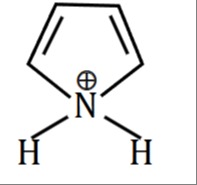Question
Question: The provided image shows a chemical structure, but the question itself is missing. Therefore, a comp...
The provided image shows a chemical structure, but the question itself is missing. Therefore, a complete solution cannot be provided. However, if we assume the question is asking to determine the aromaticity of the depicted compound, we can analyze the structure. The image shows a 5-membered ring with a positively charged nitrogen atom (N+) and two double bonds. The nitrogen atom is shown bonded to two hydrogen atoms.
Analysis of the depicted structure:
- Nitrogen Hybridization: If the N+ atom is bonded to two carbon atoms in the ring and two hydrogen atoms, it forms four sigma bonds. This implies the nitrogen atom is sp3 hybridized.
- Pi System: An sp3 hybridized atom cannot participate in a conjugated pi system. Therefore, the pi system would be formed solely by the four carbon atoms in the ring.
- Pi Electrons: The two double bonds in the ring contribute 4 pi electrons (2×2=4).
- Aromaticity Criteria: For a compound to be aromatic, it must be cyclic, planar, fully conjugated, and have (4n+2) pi electrons (Hückel's Rule).
- Cyclic: Yes, it's a 5-membered ring.
- Planar: The four carbon atoms are sp2 hybridized and form a planar pi system.
- Conjugated: The double bonds are conjugated.
- Pi Electrons: We have 4 pi electrons. Applying Hückel's Rule: 4n+2=4⟹4n=2⟹n=0.5. Since n is not an integer, the compound is not aromatic. A cyclic, planar, fully conjugated system with 4n pi electrons is anti-aromatic. Thus, this depicted structure is anti-aromatic.
Consideration of the Pyrrolium Cation: The structure resembles the pyrrolium cation, which is the protonated form of pyrrole. The standard pyrrolium cation has the nitrogen atom within the ring, sp2 hybridized, carrying a positive charge, and bonded to one hydrogen atom.
- In the standard pyrrolium cation:
- The nitrogen atom is sp2 hybridized and contributes one electron to the pi system.
- The two double bonds contribute 4 pi electrons.
- Total pi electrons = 1+4=5.
- Applying Hückel's Rule: 4n+2=5⟹4n=3⟹n=0.75. This is not an integer.
- Therefore, the standard pyrrolium cation is anti-aromatic.
Resonance and Aromaticity: However, the pyrrolium cation exists as a resonance hybrid. One of its resonance structures involves the positive charge being delocalized onto a carbon atom, while the nitrogen atom has a lone pair of electrons.
- In this resonance structure:
- The nitrogen atom has a lone pair, contributing 2 pi electrons.
- The two double bonds contribute 4 pi electrons.
- Total pi electrons = 2+4=6.
- Applying Hückel's Rule: 4n+2=6⟹4n=4⟹n=1. Since n is an integer, this resonance structure is aromatic.
- When a molecule has an aromatic resonance contributor, the molecule is considered aromatic.
Conclusion based on common exam context: Given that questions in exams like JEE and NEET often test the understanding of aromaticity, and that the pyrrolium cation has a significant aromatic resonance contributor, it is often classified as aromatic, despite the standard depiction leading to anti-aromaticity. The depiction in the image with two hydrogens on N+ is unusual and might be an error or a simplified representation. If the intent is to ask about the aromaticity of the pyrrolium cation in general, then it is considered aromatic due to resonance.

Aromatic
Anti-aromatic
Non-aromatic
Aromatic
Solution
The pyrrolium cation is a resonance hybrid. One resonance contributor has 5 pi electrons (anti-aromatic). Another resonance contributor has 6 pi electrons (aromatic) due to the nitrogen atom contributing its lone pair and the ring having two double bonds. Since an aromatic resonance contributor exists, the overall species is considered aromatic.
